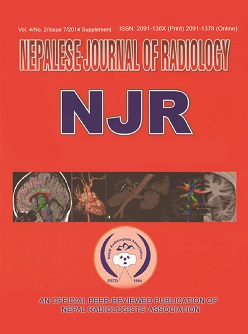Study of Portal Vein Diameter and Spleen Size by Ultrasonography and Their Association with Gastro-esophageal Varices
DOI:
https://doi.org/10.3126/njr.v4i2.18482Keywords:
Cirrhosis of liver, Gastro-esophageal varices, Portal vein diameter, Spleen size, UltrasonographyAbstract
Introduction: Upper Gastro-intestinal endoscopy is considered the best screening tool for varices in cirrhotic patients. It is still an expensive, invasive tool, has poor compliance and not routinely available in every hospitals in Nepal. This study was undertaken to establish the role of portal vein diameter and spleen size by ultrasonography in predicting gastro-esophageal varices.
Method: One hundred and fifty patients with clinical features, laboratory and sonological findings suggestive of cirrhosis of liver and endoscopic evidence of portal hypertension were included in the study. Ultrasonography assessments of portal vein diameter and spleen size alongside endoscopy for detection of varices were done.
Result: Average portal vein diameter of patients without gastro-esophageal varices was 10.800 ± 1.1402 mm, while it was 13.731 ± 1.061mm in patients with varices(p<0.001). Average spleen size of patients without varices was 12.67 ± 2.35 cm and with varices was 15.367 ± 1.210 cm (p < 0.001). There was 92.72 % sensitivity and 90 % specificity for prediction for presence of esophageal varices when the cutoff value for portal vein diameter was 12.25 mm. There was 94.5 % sensitivity and 75 % specificity for prediction for presence of esophageal varices when the cutoff value for spleen size was 13.9 cm.
Conclusion: Ultrasonography of portal vein diameter and spleen size is a reliable non invasive tool in predicting the presence of gastro-esophageal varices in patients with liver cirrhosis. With increase in portal vein diameter and spleen size, risk of formation of gastro-esophageal varices also increases and positive correlations exist between them.
Nepalese Journal of Radiology, VOL 4 No. 2 ISSUE 7 July-December, 2014: 6-14
Downloads
Downloads
Published
How to Cite
Issue
Section
License
This license enables reusers to distribute, remix, adapt, and build upon the material in any medium or format, so long as attribution is given to the creator. The license allows for commercial use.




